If you had the option of choosing a Hayward heater or a Raypak heater, which one would you choose? It’s okay if you need more time to do some research before answering. This is just an example of the type of questions our customers usually want answers to.
Owning a pool heater is still a fairly new common practice. The majority of pool owners did not purchase a pool heater ten years ago. For the most part, it was very expensive. They simply tailored their swimming season around their summer seasons and that was that. Today, it is just the opposite. Pool owners are looking for ways to extend their swimming seasons far beyond the last days of summer. The longer the season, the better. As a result, the need for pool heaters grew.
Today, most pool owners don’t need persuasion to purchase a heater. From experience, they simply want recommendations on which heater to purchase. Although we carry a wide variety of pool heaters, customers appear to be most familiar with Hayward and Raypak heaters. In fact, Hayward and Raypak heaters are our most popular heaters to date.
Still, purchasing a pool heater can be a daunting task for most pool owners. At first glance, all pool heaters seem the same, but when you look a little further, you realize each heater has specific benefits and features that may benefit one pool over the other. In other words, what may be the best heater for our customer in Florida may not be the one we recommend to a customer in California.
For our second Product Battle Series, we are determining once and for all, which is better, the Hayward heater or the Raypak heater?
Hayward Universal H-Series
What Hayward Wants You To Know
The Hayward Universal H-Series gas heater is one of the leading energy-efficient heaters in the industry. What makes it so efficient is the hydraulic design, which reduces the amount of time you have to run the circulation pump. Remember, the less you have to run your equipment, the less energy you’re using, and the more money you’re saving. The new patented polymer header protects against the damaging effects of erosion from high flow or aggressive water chemistry conditions.
Low NOx Emissions
The Universal H-Series heater emits minimal amounts of low NOx emissions into our environment, protecting our atmosphere and qualifying you for any available rebates. This is especially important to pool owners in California who receive extra savings for low NOx heaters. This is also combined with a cupro-nickel heat exchanger, as opposed to Copper. In fact, a low NOx rating and a cupro-nickel heat exchanger do not come standard in most pool heaters. You actually have to purchase a different model. For Hayward, though, this is the standard.
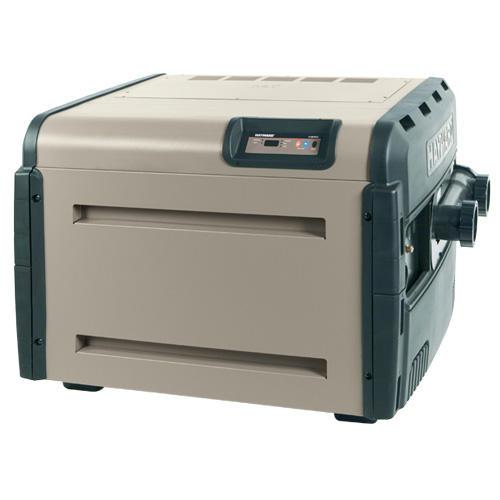
Cupro-nickel Heat Exchanger
A cupro-nickel serves two purposes. First, the cupro-nickel heat exchanger is designed to withstand the harshness of salt over longer periods of time. So, if you have a saltwater generator or plan on getting one, a cupro-nickel heat exchanger is the way to go. A cupro-nickel heater is also a lot more forgiving on pools with fluctuating chemical levels. One of the leading causes of a faulty heat exchanger is chemical corrosion. If you’re one of those pool owners who have a hard time keeping up with the chemicals in your pool, you may want to consider a heater with a cupro-nickel heat exchanger.
The H-Series Standard
The H-Series has a few more cool benefits that set this heater apart from the Raypak heaters. First, it has a forced-air draft system. The forced air draft system prevents the outside temperature from affecting the total efficiency of your heater. In other words, you won’t have to run your heater longer just because it’s cold or windy outside. You can actually track your current water temperature and how efficient your heater is directly from the L.E.D. control panel. The L.E.D. control panel also provides a digital temperature readout, diagnostics, and an electronic ‘lockout’ of temperature set point.
The Hayward Universal H-Series heater is universal, making it a perfect option for new and existing pool and spa applications. The gas and water connections can rotate to both the left and right sides of the heater, making it flexible for any installation.
What also sets the Hayward heater apart from the Raypak heater is that all of the features come in the most standard model. You don’t have to worry about picking the wrong model or paying more for a particular model just because of its features.
Features and Benefits
- Energy-efficient with 18% in savings
- 2″ x 2.5″ CPVC unions
- Common union for installation or service and adapts to larger plumbing
- Standard cupro-nickel heat exchanger
- Low NOx emissions meet all clean air quality standards
- Available in a wide variety of sizes (150k-500k BTUs)
- Patented bypass design for superior hydraulic performance
- Forced draft system
- L.E.D. control panel
- Dual Voltage
- Silicone nitride ignition switch
Technical Specifications
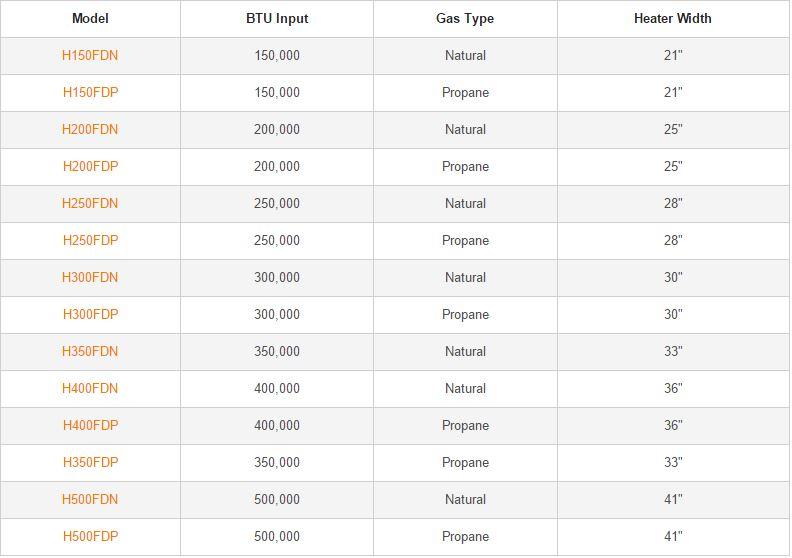
Related Links
Employee Comments & Reviews
Employee #1: Overall, I hear few complaints about the Hayward heaters but when I do it’s usually about the upfront price of the heater and that the wiring for the install is a bit complicated.
Employee #2: When I owned my business, the Hayward heater was more common than the Raypak heaters. Hayward has a very small environmental footprint and has easy access to replacement parts.
Employee #3: With Hayward, you are paying for the upgraded options. Ask yourself, do you need or want these options?
Employee #4: Make sure you hire a professional to wire your Hayward heater. You have to actually move a particular plug on the heater and failing to do so increases the chances of frying your heater.
Employee #5: Consider what you are paying for. With Hayward, you are paying for upgraded options.
Customer Reviews
Customer # 1: The price was reasonable for the features I needed for my pool.
Customer #2: No cons right now. I like that I can easily convert to natural gas if I need to.
Customer #3: If you purchase a Hayward heater, make sure you call Hayward to locate a recommended installer. They do the best work and secure your warranty with Hayward.
Raypak 2100 Series
What Raypak Wants You To Know
What makes Raypak so popular is their parent company, Rheem. Rheem is one of the nation’s leading manufacturers that produces residential and commercial water heaters, boilers, air conditioning, and ventilating systems. One of the reasons why the Raypak brand is so popular is because of the familiarity with the Rheem brand.
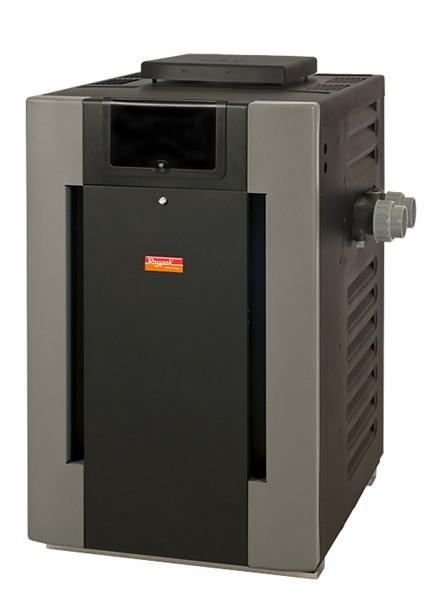
Raypak has proven to be a reliable, affordable heater for pool owners across the nation. Raypak offers a complete line of residential pool and spa heaters that fit into almost any application and situation. Unlike the Hayward H-Series heaters, the standard residential Raypak heater does not come with Low NOx emissions nor a cupro-nickel heat exchanger. Don’t fret, though, Raypak does offer a heater with Low NOx capabilities and one with a cupro-nickel heater. A low NOx rated or cupro-nickel heater costs more than the standard Raypak heater and is a completely different model than the standard heater.
Still, the standard Raypak heater is still one of the best-selling heaters we carry.
Control Systems
The Raypak heater has a microprocessor-controlled thermostat. The thermostat on the heater allows you to precisely set your temperature by simply pressing the up and down button in the preferred setting. The thermostat displays the heating process and alerts you once the pool reaches the desired temperature.
Raypak also utilizes an on-board diagnostic control for their heater. It displays exactly what is wrong with the heater in plain English and not in a code you have to decipher. Trust us when we say, heater error codes are no fun. Another cool thing about Raypak heater is its ability to record how long the heater runs and how many times it fires. This is an industry first. It provides valuable feedback for service professionals during maintenance or repair. Raypak heaters are also compatible with most popular and mainstream remote control systems on the market. Pretty much any two or three-wire remote has the ability to integrate into Raypak heaters.
Copper Heat Exchanger
The standard Raypak heater comes with a copper heat exchanger. The engineered Unitherm Governor sets this heat exchanger apart from other copper ones. The governor controls the temperature and flow rate in the heater, eliminating condensation, soot, and scale build-up. It is safe for you to use a copper heat exchanger on a salt pool. However, it is less forgiving in pools with fluctuating chemical levels.
Flame & Burners
The Raypak heater consists of stainless steel burners that self-adjusts to compensate fluctuating gas pressure. They are easily removable and serviceable. Raypak also includes a “spark to pilot” ignition system that helps guarantee the heater stays lit.
One of the biggest concerns for heaters with pilot flames is their reluctance to stay lit. Well, Raypak has found a way to relieve some of those worries. Raypak heaters are the first to monitor and measure the pilot flame signal. This is called the flame strength indicator. Raypak took a feature on most commercial pools and applied it to residential pools. In essence, this is a service man’s dream. Raypak also uses this feature to test heaters before they even leave the factory.
Onboard Voltmeter
The onboard voltmeter monitors the low voltage electrical supply. This ensures the heater is wired properly during the initial installation. It also lets you know if the voltage dropped too low for the heater to properly function.
Raypak Models
High Altitude Heaters
Pool owners located above sea level must purchase a high altitude heater. Failing to do so will cause your heater to act in a defective manner. The issue is not the heater but the low oxygen levels. All gas appliances, including pool heaters, need fresh air containing oxygen for complete combustion. The higher you go above sea level, the less oxygen is in the air, and the more likely your heater will not function.
The Raypak High Altitude residential heaters handle elevation levels as high as 9,000 feet but only uses natural gas.
Cupro-Nickel Heaters
The Raypak heater has cupro-nickel fin tube heat exchangers for added protection against aggressive water chemistry. Although rare, there are applications like health club spas, where copper is just not the best choice. Cupro-nickel offers superior tolerance to bad or fluctuating water chemistry. Its fins have a harder surface and thicker walled fin tube. Unlike the high-altitude models, the cupro-nickel heaters use both propane and natural gas.
Low-NOx
Low-Nox heaters are a more environmentally safe way to heat your pool. They use combustion control to minimize levels of nitrogen oxide (Low-NOx). This controls a number of emissions released from the heater into the atmosphere. Low-NOx heaters also comply with California Air Quality Emissions Standards and qualify for state rebates as well. The Raypak low-NOx model comes in four sizes, includes a copper fin tube heat exchanger, and available in natural gas only.
Features & Benefits
- LCD digital display provides accurate temperature
- Dial control for temperature selection and heater settings
- Monitors operational status and service diagnostics
- High-wind resistance
- Corrosion-resistant headers
- Unitherm governor prevents condensation
- 2″ PVC threaded union plumbed directly to heater
- Can be installed on combustible surfaces
- Thermal efficiency of 83%
Technical Specifications
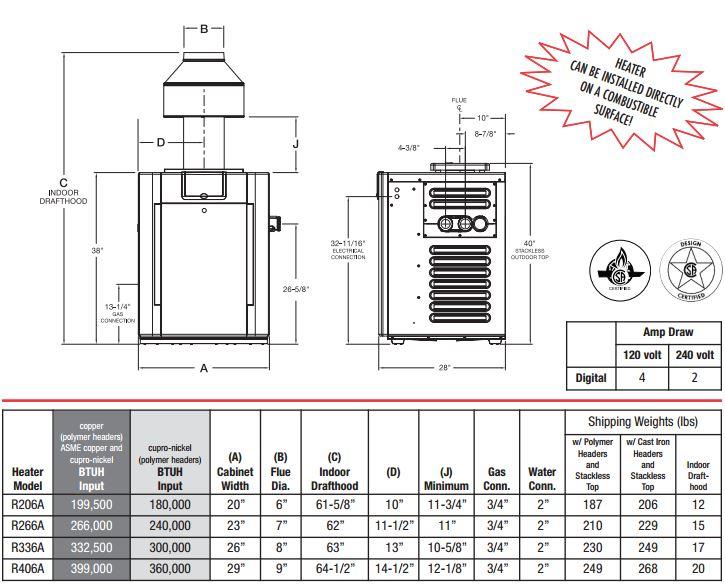
Related Links:
Employee Comments & Reviews
Employee #1: I honestly prefer the Raypak over the Hayward because of the price and reliability. It makes no sense to purchase a heater for the name to justify the price.
Employee #2: I tend to recommend the Raypak because it has more customizable options. It’s also manufactured by the leader in residential HVAC. The powder-coated steel exterior will never fail.
Employee #3: The Raypak heaters are easier to install because it has simple wiring. It also has the same plumbing as Jandy heaters, making it a great replacement, as well.
Employee #4: The Raypak units are flexible in terms of gas pressure thru the hex. It also has fewer parts for replacement or that could break.
Employee #5: Depending on the space, I would go with the Raypak heater.
Customer Reviews
Customer # 1: The electronic controls are easy to use and easy to maintain water temperature at setpoint. The electronic ignition never fails. The polymer headers, the slip fittings, and flange nuts made piping installation simple.
Customer #2: So far we are very pleased with the performance of the Raypak heater. We live in the Midwest and open our pool in mid-April and we don’t close to mid-October, so we use the heater a lot. It heats quickly and seems to be efficient. So far no cons.
Customer #3: This is our 2nd RP2100, the first lasted over 10 years, but rotted out after hurricane Sandy. Now that Rheem has purchased RayPak, the quality of the unit is noticeably higher and much improved. It still aligns 1:1 with the old units, but most all common problems have been addressed. One caveat for all pool heater owners. You must put a check valve out the output side of your heater to ensure that chlorine from the chlorinator does not pull back into the heater when the pump goes off. That will destroy the heat exchanger in a short period of time. If you do have a check valve, make sure to open and inspect it at the start of the season to make sure it is sealing properly
Customer #4: Parts are easy to replace, it was a near drop-in replacement for my old one. Get the largest BYU output you can afford. I went from the 333K to the 415K and I am super happy with the extra heat and efficiency
Customer #5: Cons – I can’t read the display unless I lift open the door (That really bothers me because I can’t read the pool temperature looking over the filter area fence).
Battle 2 Winner: Raypak 2100 Series
Overall, the majority of the feedback I received from customers and coworkers mirrored each other. Sure, both heaters are great units to heat up your pool, however, the overall customization with Raypak is better suited for most customers. With Raypak, you only purchase the features that are necessary for your pool set up. Although the Hayward heater comes fully loaded, not everyone wants or needs the additional services the Hayward heater provides. Yes, we are in the business to make money, but we are not in the business in making you spend unnecessary money. If you were interested in a fully loaded heater, not accounting for cost, then I’d definitely recommend the Hayward heater.

Hayward Gas Heaters
Heat your pool with a Hayward Universal H-Series Heater
- Cupro Nickel Heat Exchangers
- Low NOx Emissions
- Propane & Natural Gas Options

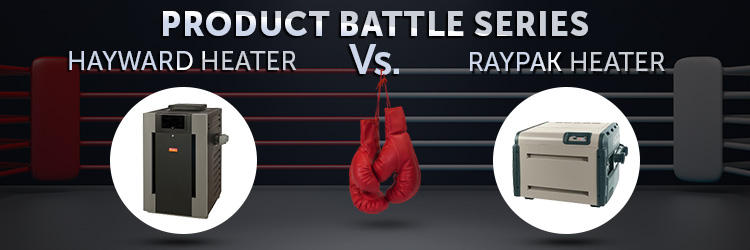







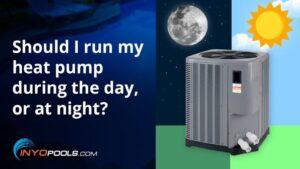

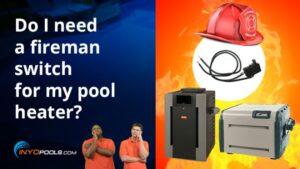
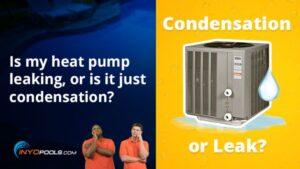
Leave a Reply